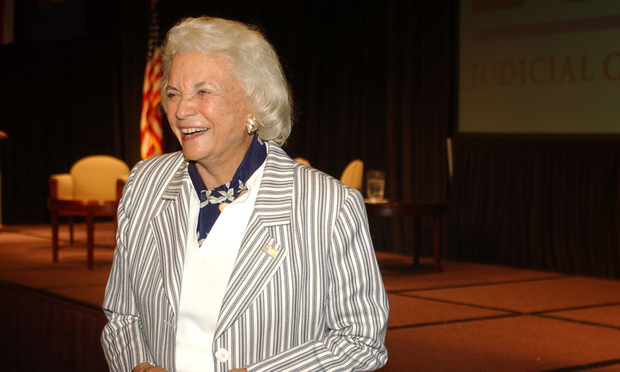Justice Sandra Day O'Connor Has Left Her Mark on These Law Schools
Stanford Law School; Arizona State University Sandra Day O'Connor College of Law; and the College of William and Mary Marshall-Wythe School of Law have each benefited from connections with Sandra Day O'Connor, who said this week that she is retiring from public life due to medical issues.
October 25, 2018 at 02:54 PM
7 minute read
 Justice Sandra Day O'Connor in March 2017. Photo: Jason Doiy/ALM
Justice Sandra Day O'Connor in March 2017. Photo: Jason Doiy/ALMSandra Day O'Connor's announcement this week that she is retiring from public life due to her diagnosis of early-stage dementia has legal educators reminiscing about her myriad contributions to the law and her impact on their schools.
The nation's first female Supreme Court justice, O'Connor has delivered her message on the importance of the rule of law and the responsibilities of lawyers to uphold it directly to budding attorneys in commencement addresses, panel discussions and other campus visits over the years.
O'Connor has forged special relationships with three particular law schools, and leaders from those schools share here what her involvement has meant to their institutions. First is Stanford Law School, where O'Connor launched her legal career. Next is Arizona State University's law school, which bears her name. Third is the College of William and Mary's law school, when the retired justice served as the chancellor of the university from 2005 to 2012.
Stanford Law School
O'Connor was something of an anomaly when she enrolled at Stanford Law School in 1950. Not only was she among the relatively few women to pursue a law degree at the time, but she was also remarkably young to attend the prestigious law school.
O'Connor was admitted to Stanford University at just 16, where she completed her undergraduate degree in economics. That allowed her to start her law degree at a relatively young 20. But she wasn't done with her accelerated timeline. She finished her degree in two years instead of the traditional three.
Still she excelled, graduating third in her class. (One of the two classmates who bested her grades was William Rehnquist, who would go on to serve on the high court with O'Connor. The two also briefly dated as law students, before she met and married her husband, classmate John Jay O'Connor III.) But O'Connor's academic excellence didn't help her on the employment front, where she initially struggled to secure paid legal work because of her gender.
O'Connor's ascent to the high court is a point of pride for Stanford, which hasn't had an alum on the Supreme Court since her retirement from the bench in 2006. Rehnquist died the previous year, while still a sitting justice. Each of the current justices attended either Yale, Harvard or Columbia.
The Stanford Law Review—where O'Connor served as an editor during her time on campus—in 2010 published an edition honoring her and Rehnquist and O'Connor, complete with an appreciation from newly retired Supreme Court Justice Anthony Kennedy. “The years at Stanford gave them their skills as scholars and professionals,” Kennedy wrote. “Those years, too, helped them find their self-definition, their sense of identity. At Stanford, they continued to shape their ethical frameworks and their beliefs that the individual can, and must, contribute to the progress of a free society.”
Arizona State University Sandra Day O'Connor College of Law
In 2006, Arizona State University renamed its law school in honor of O'Connor, who retired from the U.S. Supreme Court that same year. At the time, it was the only law school in the country named for a woman. (Pace University became the second when it was rebranded the Elisabeth Haub School of Law at Pace University in 2016.) The renaming made sense. O'Connor is an Arizona native, having spent much of her early life on her family's ranch near the state's border with Mexico.
O'Connor was also a member of the Arizona Legislature that in 1965 approved the creation of a law school at Arizona State University. “I am so touched to have my name now on this law school, but it is going to restrict my activities you know because I certainly don't want to bring any discredit now to this law school,” she quipped at the 2006 renaming ceremony. “So in my retirement I guess I am going to have behave myself.”
O'Connor has stayed connected to the law school ever since. She co-taught a course on the separation of powers for several years with Arizona Supreme Court Chief Justice Scott Bales, most recently in 2008. She was back on campus in February 2017 for a celebration in honor of former President Jimmy Carter, and dropped by in the summer of 2017 to visit students in Camp O'Connor—a five-day summer camp for middle school students focused on leadership and democracy.
“There has been no greater champion for the things we value most as a society—justice, equality and the rule of law—than Sandra Day O'Connor,” said ASU Law Dean Doug Sylvester. “As the first woman to lead a state senate, to serve on the U.S. Supreme Court, and to have a name attached to a law school, Justice O'Connor exemplified what it meant to live a life of public service and uphold the rule of law. Justice O'Connor took the responsibility of having her name on a law school very seriously and when she was able, spent time with students at the law school instilling the importance of civic duty as part of their legal education.”
College of William and Mary Marshall-Wythe School of Law
The role of chancellor at the College of William and Mary is largely ceremonial, but O'Connor used that appointment from 2005 to 2012 to forge a strong connection to the university's law school, according to Dean Davison Douglas. O'Connor would visit the university three or four times a year and made a point to come to the law school and interact with students.
Sometimes she would drop in on a class, other times she would meet with a group of students over lunch. Douglas recalled one event where O'Connor met an undergraduate who she believed had great potential as a lawyer. “She marched right over to me at a reception and said, 'I think this student is outstanding and I think he should be admitted to the law school,'” Douglas said. “It turns out that he was a good student and we did admit him to the law school, but she was quite hands-on.”
William and Mary law students also have O'Connor to thank for the addition of a quoits pit—which is a game similar to horseshoes except played with iron rings. O'Connor knew that former Supreme Court Justice John Marshall had attended the law school and that he played a mean game of quoits. Students needed their own place to play the game, she told Douglas. The school agreed and constructed the pit, even inviting her to an inaugural quoits tournament.
But the justice disappeared during the pre-tournament brunch, only to be found honing her quoits game at the new pit. “I love that quoits story because it kind of captured her personality,” Douglas said. “When she has an idea, she's full-blown in her support of it.”
O'Connor also delivered the law school's commencement address numerous times during her tenure as university chancellor. Her 2010 address was particularly poignant, Douglas said, as the recession was in full swing and entry-level law jobs were hard to come by. “She told her own story about how she couldn't get employed when she came out of law school,” he said. “No one would give her a job. She finally volunteered somewhere and it leads to a permanent job and she makes her way. It was the perfect story in 2010 to tell to a bunch of students who are anxious. She said, 'You'll get there. Let me tell you what happened to me.'”
This content has been archived. It is available through our partners, LexisNexis® and Bloomberg Law.
To view this content, please continue to their sites.
Not a Lexis Subscriber?
Subscribe Now
Not a Bloomberg Law Subscriber?
Subscribe Now
NOT FOR REPRINT
© 2025 ALM Global, LLC, All Rights Reserved. Request academic re-use from www.copyright.com. All other uses, submit a request to asset-and-logo-licensing@alm.com. For more information visit Asset & Logo Licensing.
You Might Like
View All
12-Partner Team 'Surprises' Atlanta Firm’s Leaders With Exit to Launch New Reed Smith Office
4 minute read
Morgan Lewis Shutters Shenzhen Office Less Than Two Years After Launch

After Breakaway From FisherBroyles, Pierson Ferdinand Bills $75M in First Year
5 minute read
Judge Rejects Walgreens' Contractual Dispute Against Founder's Family Member
5 minute readTrending Stories
Who Got The Work
J. Brugh Lower of Gibbons has entered an appearance for industrial equipment supplier Devco Corporation in a pending trademark infringement lawsuit. The suit, accusing the defendant of selling knock-off Graco products, was filed Dec. 18 in New Jersey District Court by Rivkin Radler on behalf of Graco Inc. and Graco Minnesota. The case, assigned to U.S. District Judge Zahid N. Quraishi, is 3:24-cv-11294, Graco Inc. et al v. Devco Corporation.
Who Got The Work
Rebecca Maller-Stein and Kent A. Yalowitz of Arnold & Porter Kaye Scholer have entered their appearances for Hanaco Venture Capital and its executives, Lior Prosor and David Frankel, in a pending securities lawsuit. The action, filed on Dec. 24 in New York Southern District Court by Zell, Aron & Co. on behalf of Goldeneye Advisors, accuses the defendants of negligently and fraudulently managing the plaintiff's $1 million investment. The case, assigned to U.S. District Judge Vernon S. Broderick, is 1:24-cv-09918, Goldeneye Advisors, LLC v. Hanaco Venture Capital, Ltd. et al.
Who Got The Work
Attorneys from A&O Shearman has stepped in as defense counsel for Toronto-Dominion Bank and other defendants in a pending securities class action. The suit, filed Dec. 11 in New York Southern District Court by Bleichmar Fonti & Auld, accuses the defendants of concealing the bank's 'pervasive' deficiencies in regards to its compliance with the Bank Secrecy Act and the quality of its anti-money laundering controls. The case, assigned to U.S. District Judge Arun Subramanian, is 1:24-cv-09445, Gonzalez v. The Toronto-Dominion Bank et al.
Who Got The Work
Crown Castle International, a Pennsylvania company providing shared communications infrastructure, has turned to Luke D. Wolf of Gordon Rees Scully Mansukhani to fend off a pending breach-of-contract lawsuit. The court action, filed Nov. 25 in Michigan Eastern District Court by Hooper Hathaway PC on behalf of The Town Residences LLC, accuses Crown Castle of failing to transfer approximately $30,000 in utility payments from T-Mobile in breach of a roof-top lease and assignment agreement. The case, assigned to U.S. District Judge Susan K. Declercq, is 2:24-cv-13131, The Town Residences LLC v. T-Mobile US, Inc. et al.
Who Got The Work
Wilfred P. Coronato and Daniel M. Schwartz of McCarter & English have stepped in as defense counsel to Electrolux Home Products Inc. in a pending product liability lawsuit. The court action, filed Nov. 26 in New York Eastern District Court by Poulos Lopiccolo PC and Nagel Rice LLP on behalf of David Stern, alleges that the defendant's refrigerators’ drawers and shelving repeatedly break and fall apart within months after purchase. The case, assigned to U.S. District Judge Joan M. Azrack, is 2:24-cv-08204, Stern v. Electrolux Home Products, Inc.
Featured Firms
Law Offices of Gary Martin Hays & Associates, P.C.
(470) 294-1674
Law Offices of Mark E. Salomone
(857) 444-6468
Smith & Hassler
(713) 739-1250








